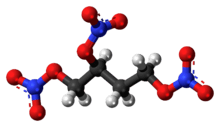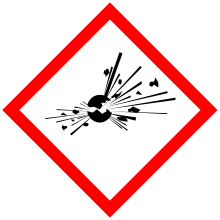1,2,4-Butanetriol trinitrate
 | |
| Identifiers | |
|---|---|
3D model (JSmol) |
|
| ChemSpider | |
| ECHA InfoCard | 100.026.998 |
| EC Number | 229-697-1 |
PubChem CID |
|
| |
| |
| Properties | |
| C4H7N3O9 | |
| Molar mass | 241.11 g/mol |
| Melting point | 250k |
| Hazards | |
| GHS pictograms |     |
| GHS signal word | Danger |
| H200, H300, H310, H330, H373, H411 | |
| P201, P202, P260, P262, P264, P270, P271, P273, P280, P281, P284, P301+310, P302+350, P304+340, P310, P314, P320, P321, P322, P330, P361, P363, P372, P373, P380 | |
Except where otherwise noted, data are given for materials in their standard state (at 25 °C [77 °F], 100 kPa). | |
| Infobox references | |
1,2,4-Butanetriol trinitrate (BTTN), also called butanetriol trinitrate, is an important military propellant. It is a colorless to brown explosive liquid.
BTTN is used as a propellant in virtually all single-stage missiles used by the United States, including the Hellfire. It is less volatile, less sensitive to shock, and more thermally stable than nitroglycerine, for which it is a promising replacement.
BTTN as a propellant is often used in a mixture with nitroglycerin. The mixture can be made by co-nitration of butanetriol and glycerol. BTTN is also used as a plasticizer in some nitrocellulose-based propellants.
BTTN is manufactured by nitration of 1,2,4-butanetriol. Biotechnological manufacture of butanetriol is under intensive research.
References
External links
This article is issued from
Wikipedia.
The text is licensed under Creative Commons - Attribution - Sharealike.
Additional terms may apply for the media files.